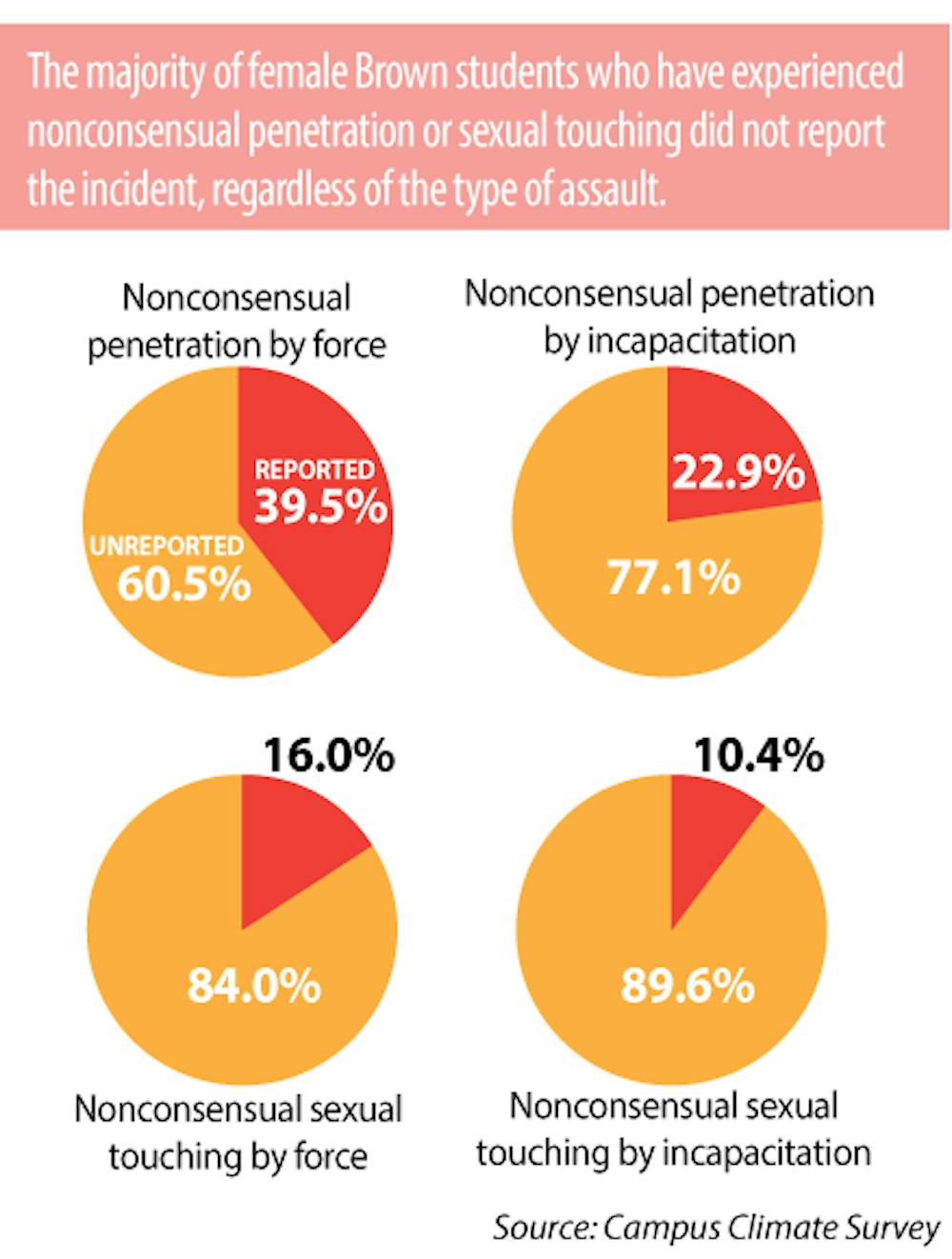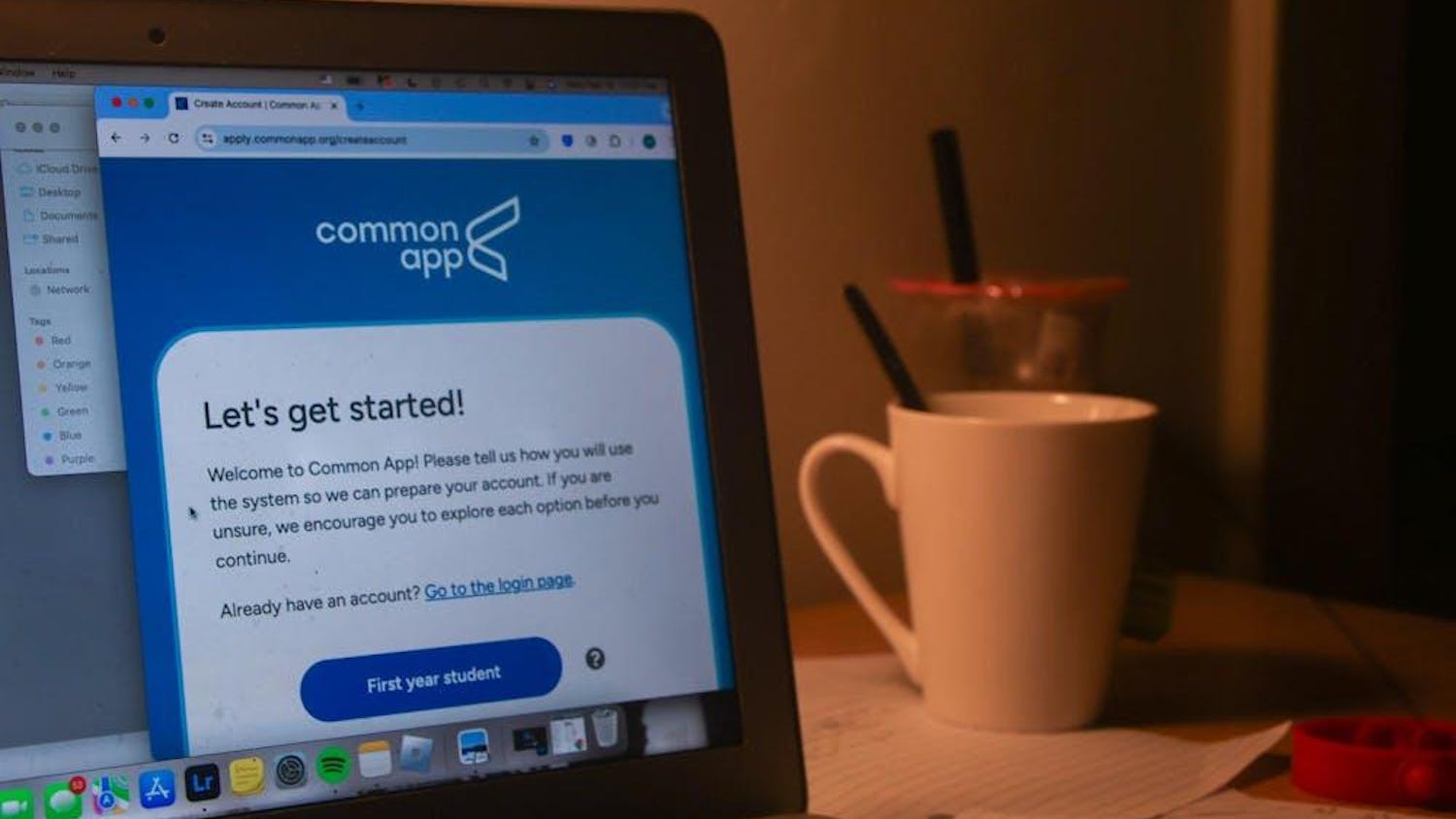Twenty-five percent of undergraduate women reported having experienced sexual assault — attempted or completed non-consensual penetration or non-consensual sexual touching by force or incapacitation — since enrolling at Brown, compared to a national average of 23 percent, according to a report released Monday.
The report, which outlines the results of a spring survey conducted by the Association of American Universities, corroborates the much-disputed statistic from a 2007 survey funded by the Department of Justice, which states that “one in five” women are victims of sexual assault.
Approximately 25.7 percent of undergraduates identifying as TGQN — transgender, genderqueer, gender non-conforming, questioning or non-listed — reported having experienced sexual assault, as did 6.8 percent of male undergraduates. These numbers both lie above the national averages of 24.1 percent and 5.4 percent, respectively.
In the survey, non-consensual penetration was defined as instances in which penetration was either attempted or completed.
Among female undergraduates, 10.1 percent indicated experiencing non-consensual penetration involving force or incapacitation during their time at the University, a figure in line with the nationwide average of 10.8 percent.
In this same category, TGQN students reported 13.2 percent, a figure above the national average of 12.4 percent. For male undergraduates in this category, the figure is 2.7 percent, coming close to the national average of 2.2 percent.
Methodology
The survey, the largest on sexual assault and campus climate in history, collected responses from 150,000 undergraduates across 27 of the AAU’s 62 member institutions. Several colleges dropped out of the survey after leading sexual assault researchers pointed out perceived flaws in its methodology last spring.
Russell Carey ’91 MA’06, executive vice president for planning and policy, represented Brown as chair of the AAU’s Request for Proposals team, which was responsible for choosing the firm Westat to conduct the survey. While smaller surveys to assess campus climate have been completed at the University in the past, they have not been as rigorous nor as expansive as the AAU’s, he said.
The survey was emailed to 8,638 Brown undergraduate, graduate and medical students, 36.3 percent of whom responded. Nationally, only 19.3 percent of the 780,000 students who were emailed completed the survey. While that number is low in comparison to other surveys on the topic, which have generated a response rate between 30 and 80 percent, the sample size is unprecedented, according to the report.
Students who completed the survey were given a $5 gift certificate to encourage their responses. Those who did not take the survey after the initial email were offered a chance at a $500 prize, though they only needed to click a link to be entered into the raffle, which did not require completion of the survey, according to the report.
“We hoped that this would minimize the self-selection bias,” said Title IX Officer Amanda Walsh. “They have another motivation to participate outside of perhaps their own experience or victimization.”
Even if students who had experienced sexual assault responded at a higher rate than those who had not, the number of reported incidents is large enough to warrant serious University attention, Walsh said.
Sexual assault and reporting
The AAU report provides data confirming that students identifying as TGQN experience sexual assault at higher rates than their peers. At Brown, TGQN undergraduates reported sexual assault rates in line with those of female undergraduates.
Notable differences also persisted based on sexual orientation. The report indicated that 22.7 percent of non-heterosexual Brown students experienced sexual assault, compared to 11.2 percent of heterosexual students.
Seniors, whose reporting of sexual assault encompasses nearly their entire Brown experience, indicated experiencing sexual assault at slightly higher rates. Approximately 33 percent of senior females, 24.3 percent of senior TGQN students and 8 percent of senior males reported having experienced attempted or completed non-consensual penetration or non-consensual sexual touching, by force or incapacitation, since entering Brown.
Nationwide, the numbers compare at 27.2 percent of female seniors, 30.8 percent of TGQN seniors and 6.5 percent of male seniors.
Focusing further, 13.4 percent of senior women reported having experienced attempted or completed penetration since arriving at Brown, while 24.3 percent of TGQN seniors and 4.1 percent of male seniors reported the same.
The majority of female students chose not to report incidents of sexual assault to the University in all types of cases. The numbers reflect that more female students chose not to report non-consensual penetration to the University when incapacitated — 77.1 percent did not report — than when penetrated by force — 60.5 percent did not report.
Students who said they chose not to report incidents of sexual violence indicated several lines of reasoning. For non-reporting female students who indicated experiencing penetration by force, 70.5 percent did not think the incident was serious enough to report, and 47.9 percent believed nothing would be done.
For female students who reported experiencing unwanted touching at Brown, the rates of not reporting increased even further. Approximately 84 percent of female students who said they had been sexually touched by force also said they did not report the incident. And approximately 90 percent of female students who said they had been sexually touched while incapacitated also said they did not report the incident.
“There are behaviors that some people minimize or dismiss,” Carey said. “To the person on the receiving end, that is very serious.”
Trends prevalent in the undergraduate community were reflected amongst graduate and medical students. Of female graduate and medical students, 8 percent reported having experienced sexual violence by force or incapacitation during their time at Brown.
Carey said while several of these figures are “sobering,” he was not surprised by the report. Rather, the data in the survey reflects the evidence presented by various community members and the research gathered by the Task Force on Sexual Assault, he said.
“We want to make reporting (incidents of sexual assault) something that individuals will take advantage of,” Carey said, adding that the University hopes its new Title IX updates have increased students’ trust.
“We have to take into account that students don’t report (sexual assault) because they don’t trust the administration to do the right thing,” said Christine Lee ’18.
Students’ distrust in the University “is a major challenge that we need to address,” Carey said.
Jillian Lanney / Herald
Sexual harassment, intimate partner violence and stalking
Around 55.8 percent of Brown students reported having experienced sexual harassment, 7.8 percent reported having experienced intimate partner violence and 4.2 percent reported having experienced stalking since starting college.
A much greater percentage of TGQN students than the average — 89.9 percent — reported experiencing harassment. All TGQN students who reported experiencing harassment said this harassment came from another student, while 14.4 percent said it additionally came from a faculty member.
A higher percentage of TGQN students — 30.3 percent — also reported higher rates of intimate partner violence.
“Nationally, the rate of violence in the trans community is higher than other groups,” Walsh said. “They tend to feel less safe than other groups.”
Moving forward, the Title IX Office hopes to increase awareness that the office is meant to handle cases of not only sexual assault, but also sexual harassment and intimate partner violence, Walsh said.
Campus Climate
Nearly 35 percent of students “believe that sexual misconduct is a problem on campus,” according to the University’s summary of the Brown AAU data, and “female undergraduates express the highest level of concern.”
This statistic is expected, Walsh said, given the higher rates of sexual assault among women.
“Community-wide, we want everyone to understand that this is an issue on campus. There’s a perception that this is an undergraduate female issue,” she said. “Changing that perception is a goal that we hope will come out of the survey results.”
“Both this report and (the Task Force on Sexual Assault’s) final report indicate that we have a campus climate problem,” Carey said.
The data reveals student distrust in the University’s reporting process. Only 25.6 percent of students believe campus officials would conduct a fair investigation of a report. Around half of students believe officials would take a report seriously, and 44.6 percent of students believe officials would protect the person’s safety. Distrust in the University’s reported process emerged as higher for female students than for male students.
While the University has already put in place many of the recommendations made by the task force in its final report, the impact of these changes may not be evident until the survey is repeated in three to four years, Walsh said.
“One way we can see whether there is an increase in trust is looking at whether there is an increase in complaints,” she added. “That will take time. Just as students hear from one another that the system is not working well, they will also hear that it is working well.”
“Changing the process isn’t enough,” said Emily Schell ’16, co-founder of Stand Up!, a group that works to prevent sexual assault on campus. “It’s changing the attitude and ensuring that survivors have trust in the institution — enough trust to report their case.”
The University will also use any data collected in the future to evaluate a change in campus culture around bystander intervention as a result of the new sexual assault training implemented this fall. The AAU’s data indicates that 24.2 percent of students have witnessed someone acting in a sexually violent or harassing manner since enrolling at Brown. Of those students, 44.5 percent took action.
Amongst the 24.8 percent of students who said they suspected a friend was sexually assaulted, 67.4 percent said they took action. More than half of students — 54.1 percent — said they witnessed a drunken person heading for a “sexual encounter,” but only 22.9 percent said they intervened. Of the 77.1 percent who said they did not take action, 24.5 percent reported they were unsure of what to do.
This new information allows the University to tailor its training to place more emphasis on subjects in which students lack clarity, Walsh said.
Training will also focus on more positive acts, such as consent.
The data sheds light on positive aspects of Brown’s culture, too, Carey said. Of all Brown students surveyed, 70.3 percent said they believed a victim who made a report would be supported by peers.
“This statistic speaks loudly to the type of student community Brown is made of,” said Yuna Hur ’18. “With strong supportive efforts present among the student body, it is reassuring to me that when instances do occur, fellow classmates would likely come together as a cohesive body.
Resources
Knowledge of resources varies across campus. A majority of students indicated awareness of the services provided by Counseling and Psychological Services and the Sexual Assault Response Line — 81.1 percent and 59.5 percent, respectively. The Office of Campus Life was satisfied with these numbers, given that survey respondents may not have had direct experience with CAPS and the response line, said Vice President for Communications Cass Cliatt.
Students also expressed confidence in where to seek help at Brown if they or their friends experienced sexual assault or sexual misconduct. A majority of students — 70.2 percent — reported feeling somewhat to extremely knowledgable about this subject.
As for awareness about what happens after a student reports sexual assault or misconduct to the University, only 41 percent of students reported feeling somewhat to extremely knowledgable.
“Transparency around available resources is something we are continuing,” Walsh said, adding that materials addressing these resources are featured on the new Title IX website. The Title IX Office will also work with student groups to explore peer-to-peer avenues of publicizing resource availability, she said.
The Undergraduate Council of Students will host an open forum Wednesday to discuss Title IX issues and policy at Brown, as well as the survey results.





